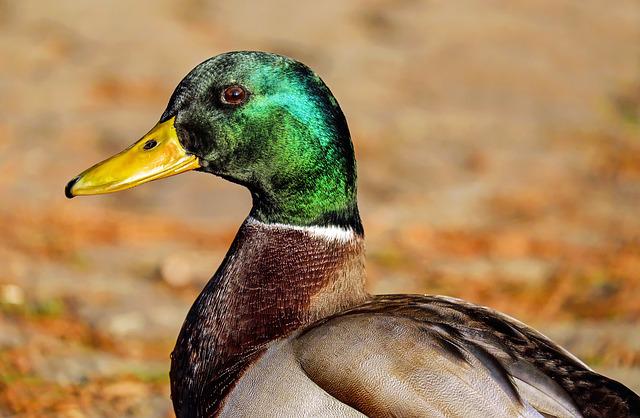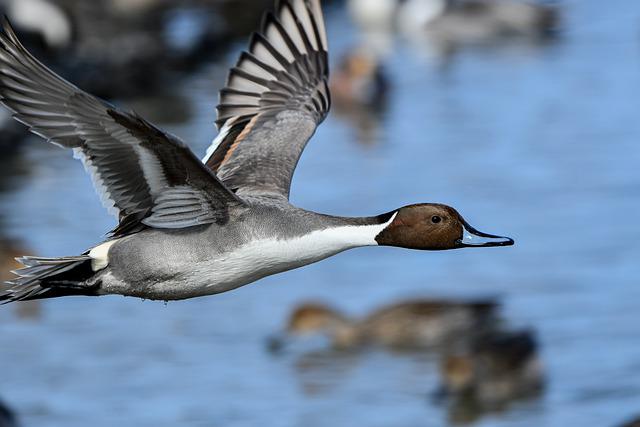The country of 10,000 ponds and lakes, Minnesota, is a wonderful sanctuary for ducks. The massive duck species draws both birdwatchers and hunters toward Minnesota.
Diving ducks and puddle ducks are abundant across Minnesota and will be located in almost all of the state’s rivers.
In this post, we’ll look at a few of Minnesota’s ducks and know a little bit about them.
| Image | Name |
|---|---|
 | MALLARD |
 | GREEN-WINGED TEAL |
 | BLUE-WINGED TEAL |
 | CINNAMON TEAL |
 | NORTHERN PINTAIL |
 | GADWALL |
 | AMERICAN WIGEON |
 | NORTHERN SHOVELER |
 | WOOD DUCK |
 | AMERICAN BLACK DUCK |
 | CANVASBACK |
 | REDHEAD |
Different Species of Ducks in Minnesota (MN)
Minnesota is a habitat for several duck types, including well-known species such as Pintails, Teals, Mallards, Canvasbacks, and Wood Ducks, and a variety of lesser-known species such as Buffleheads and Black Ducks.
1. Mallard

| Scientific name | Anas platyrhynchos |
| Weight | 2.5 to 3 pounds |
| Length | 24 inches |
| Wingspan | 2.7 to 3.2 feet |
Mallards are possibly the most well-known duck breed. The males’ bright green heads are perhaps what most people see when they think of hunting ducks.
These ducks may be located across Minnesota in ponds, wetlands, and lakes, as well as in rural, urban, and suburban locations.
Males get a pale green head, a dark reddish-brown breast, a small white neck, a black rump, a yellow beak, and a white-tipped tail.
Females have speckled brown bodies as well as brown or orange bills. The additional purple-blue plumage on both sexes’ wings is also most evident while they are soaring or sitting.
2. Green Winged Teal

| Scientific name | Anas carolinensis |
| Weight | 4.9 to 17.6 ounces |
| Length | 12.2 to 15.3 in |
| Wingspan | 20.5 to 23.2 in |
The green-winged teal, North America’s tiniest dabbling duck, may be spotted throughout the year in Minnesota, favoring marshes and seasonal wetlands within surrounding forests.
They like to mate and nest in densely forested environments.
Males are chestnut-brown in color with a green ear band. Gorgeous gray-barred bellies have straight white stripes on both sides. Females possess black eye lines and are speckled brown all over.
Both sexes get a green spot on their wing that may be seen in flying and most of the time while they are resting.
3. Blue Winged Teal

| Scientific name | Anas discors |
| Weight | 1 lb |
| Length | 15 in |
| Wingspan | 23 in |
Because they are highly sensitive to cold climates, blue-winged teals move south sooner than other species. They favor back bays and tiny lakes, as well as open grassland over woods.
They’ll start migrating south around the end of September, and others will make it all the way to Colombia.
Males get a blue head with a white stripe in front of the eye. The beak and wings are both blacks. Brown has black markings on the body.
The bodies of females are brown. Looking for someone with black eyeliner and a crown over their head.
4. Cinnamon Teal

| Scientific name | Anas cyanoptera |
| Weight | 14 ounces |
| Length | 16 in |
| Wingspan | 22 in |
They are called after the hue of the drakes (males), which resembles cinnamon. These really are western birds that seem to be uncommon throughout Minnesota. Search for them in the state’s southern portion.
5. Northern Pintail

| Scientific name | Anas acuta |
| Weight | up to 3 lbs |
| Length | 23 to 30 in |
| Wingspan | 31 – 37 in |
The pintail is among North America’s biggest ducks. Pintails are usually wild birds, and they will spend the winter throughout Minnesota if they would find hidden water.
They are mostly distributed across Minnesota’s western areas, particularly near large wetlands.
Long tails and necks, as well as a delicate black-gray beak, characterize these slim ducks. Males are cinnamon-brown in color with gray bellies and a white chest and neck.
Females possess rufous-brown feathers on their bodies and simple, tan heads.
6. Gadwall

| Scientific name | Mareca strepera |
| Length | 18 to 22 in |
| Weight | 30 to 35 ounces |
| Wingspan | 31 to 35 in |
The gadwall is among North America’s most abundant dabbling ducks. They are mostly distributed across Minnesota’s northwest and west-central areas.
Some species will also overwinter, mostly in the state’s southern half. They thrive in wetlands with dense vegetation on the surface and beneath the water.
Males have a complex pattern of brown, gray, and black feathers that resemble white-fringed “scales.” The beak is dark black or grey with a brown head. Thick and dark brown plumage surrounds the back. The beak of males is black.
Females have speckled brown feathers and a dark orange-black beak. Female Mallards have a strong resemblance. When soaring, both genders have such a white patch (much less for females) on their wings.
7. American Wigeon

| Scientific name | Mareca americana |
| Weight | 1 to 3 pounds |
| Length | 17 – 23 in |
| Wingspan | 30 to 36 in |
These widespread species are normally rarely encountered throughout Minnesota while they pause on their migration journey. However, a small group might occasionally nest here.
They could usually be found near marshes in early summer and early fall.
Males appear predominantly brown, with a green band over their eyes as well as a white crown. Females possess brown bodies in general, with a grayer forehead.
Although there are many American Wigeons, they usually favor peaceful lakes and marshes away from other people. Their diet has a larger amount of plant stuff than that of other ducks, and they, like geese, will forage on farmlands.
Their small bill gives a lot of strength, allowing them to easily pick plants!
8. Northern Shoveler

| Scientific name | Spatula clypeata |
| Weight | 1.3 lbs |
| Length | 19 in |
| Wingspan | 30 in |
The Shoveler, easily identified by its huge, shovel-like beak, may be seen throughout the year in Minnesota, particularly in the southern parts. During the mating season, they prefer tiny wetland basins.
Males are distinguished by their reddish-brown sides, black backs, white chests, green heads, and yellow eyes. Females are typically brown, with a bluish wing stripe on occasion. Both genders possess characteristic broad and wide bills!
Casual onlookers across Minnesota could mistake these ducks for Mallards if they simply look at the green head. However, if you look closely, you’ll observe the Incredibly huge spoon-shaped beak that Northern Shovelers were recognized for it and how they acquired their nickname.
They utilize their huge bill to dig and sift over sand and dirt in search of hidden mollusks, crustaceans, and aquatic insects. Surprisingly, its bill features over 100 small projections called lamellae, mostly on margins that assist filter out the food that wish to consume.
9. Wood Duck

| Scientific name | Aix sponsa |
| Weight | 16 – 30 ounces |
| Length | 19 to 21 in |
| Wingspan | 26 to 29 in |
Wood ducks are little roosting ducks having vivid colors and red beaks in the males. They are found across Minnesota and favor woody marshy environments, small lakes, and marshes. They’re notably widespread in the state’s southern two-thirds.
Few waterfowl apparently adopted Walt Disney’s adage that “the earth is a carousel of color” more seriously than that of the male Wood Duck.
In reality, it appears like one artist employed every hue in the rainbow to create a duck that is blue, orange, lime, purple, buff, white, rose, tan, brown, black, yellow, gray, green, and red.
10. American Black Duck

| Scientific name | Anas rubripes |
| Weight | 1.6 to 3.6 lbs |
| Length | 21 to 23 in |
| Wingspan | 35 to 37 in |
The dark brown body between both sexes contrasted with the pale brown head. The beak of a male is yellow. Females get an olive beak that is dull.
Observe for a shimmering purple rectangular spot on their wings when soaring.
The moniker “American Black Ducks” is not doing them justice. You’d think they’d resemble the Warner Brothers cartoon Daffy Duck. However, they don’t even have any black over them!
These ducks are usually found in shallow marshes across Minnesota, where they frequently graze alongside Mallards. American Black Ducks as well as female Mallards seem oddly familiar, so keep an eye out for them in huge groups!
11. Canvasback

| Scientific name | Aythya valisineria |
| Weight | 1.9 to 3.5 lbs |
| Length | 19 to 22 in |
| Wingspan | 31 to 35 in |
Canvasbacks are so-called because of their beautiful grey-brown backs. They hatch throughout southern and western Minnesota, although they are not present in the state during the wintertime. Prairie wetlands, commonly known as prairie potholes, are where you’ll discover them.
12. Redhead

| Scientific name | Aythya americana |
| Weight | 2 to 2.5 lbs |
| Length | 15 in |
| Wingspan | 33 in |
During the summertime mating season, the redhead duck may be spotted across Minnesota, with the exception of the northeast corner. They like tiny wetlands in open, non-wooded environments, therefore, they are frequently found near canvasbacks.
Both sexes get a sharp crest that leads down to a black-tipped gray beak. Males have such unique cinnamon-red heads and golden eyes. Gray body with a black breast. Females have a paler forehead and are brownish overall. His eyes are black.
Check out this article on Types of Ducks in Florida.
Conclusion
This list should be extremely eye-opening for those individuals who are only familiar with the common Mallard! The ducks shown above are by far the most frequent and probably to be seen.
In truth, the list of ducks that might have been observed throughout Minnesota is far longer!
FAQ
What is the most frequent type of duck in Minnesota?
I’m guessing that practically everyone has heard of the Mallard. These ducks are by far the most prevalent across Minnesota!
Last Updated on March 22, 2023 by Lily Aldrin
